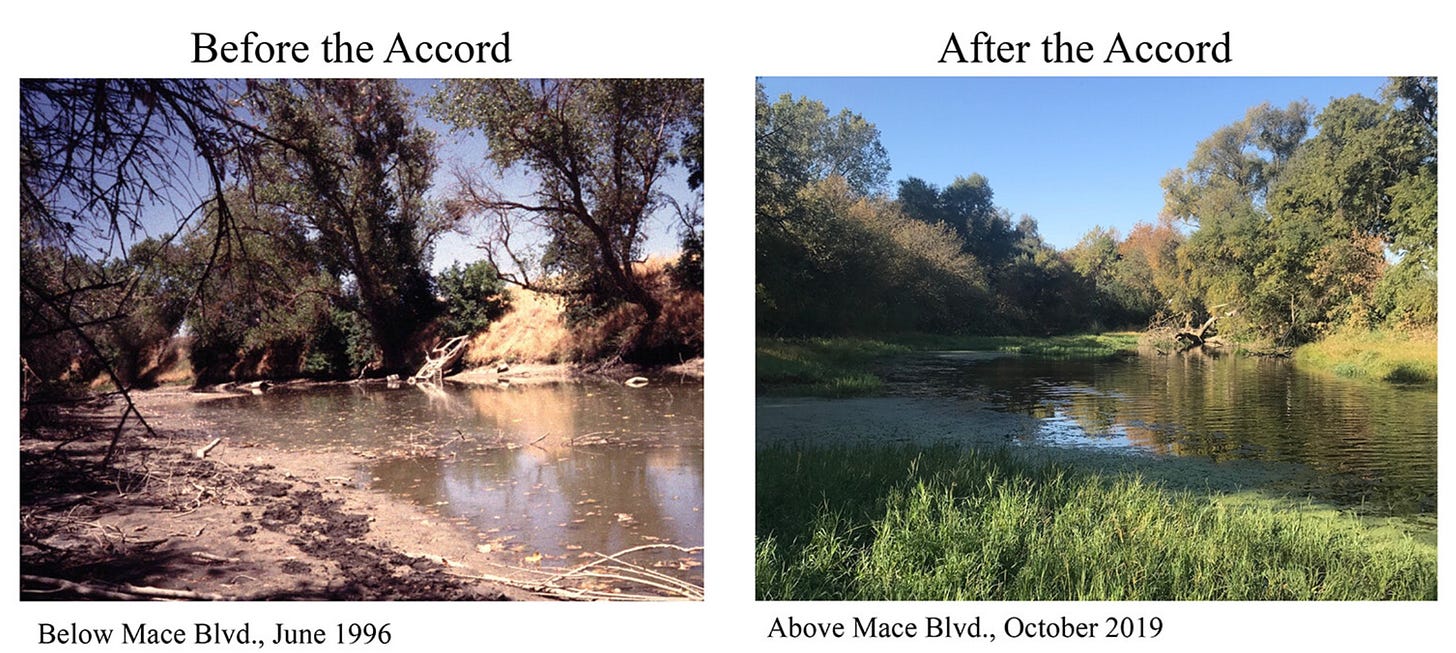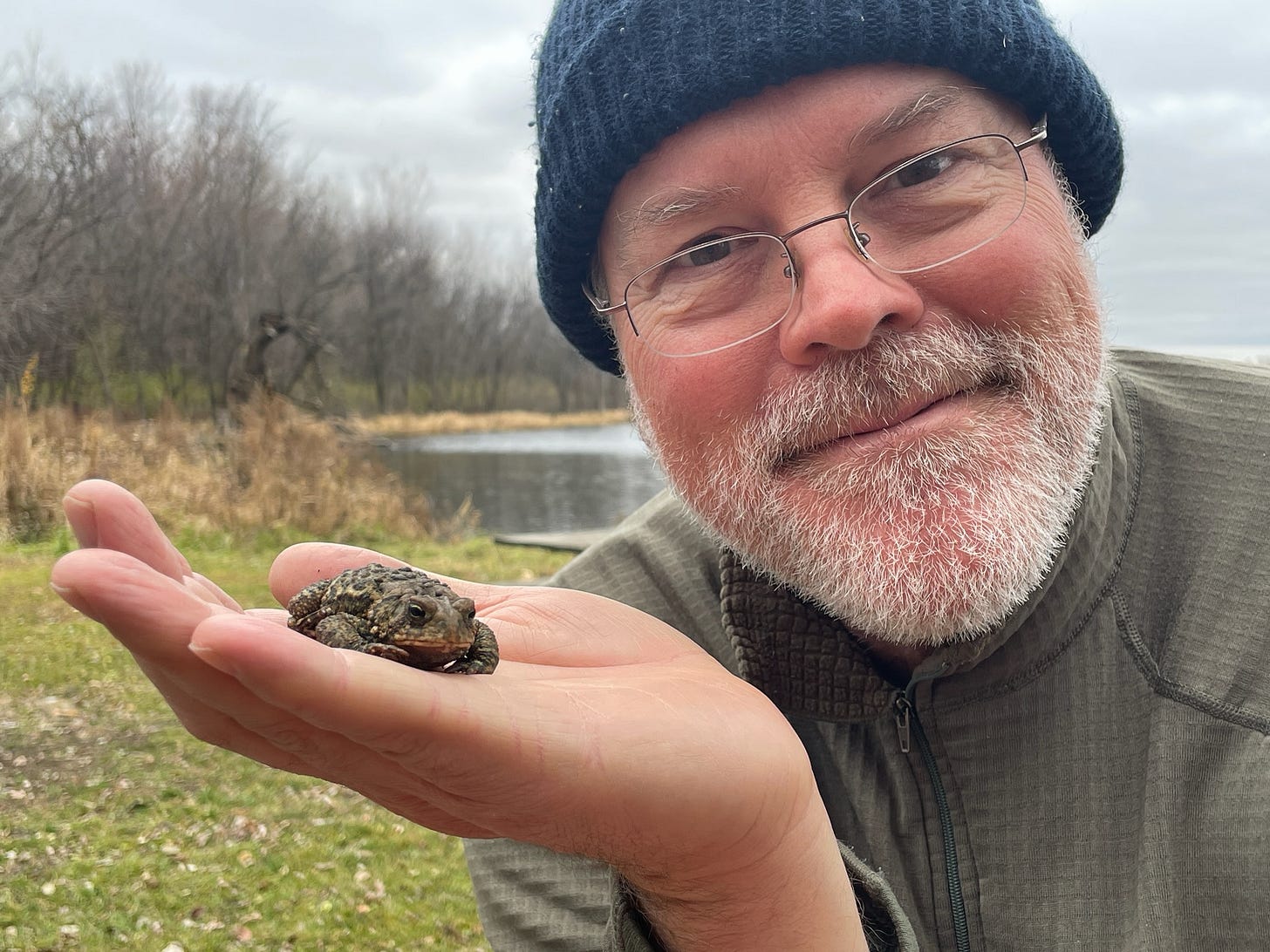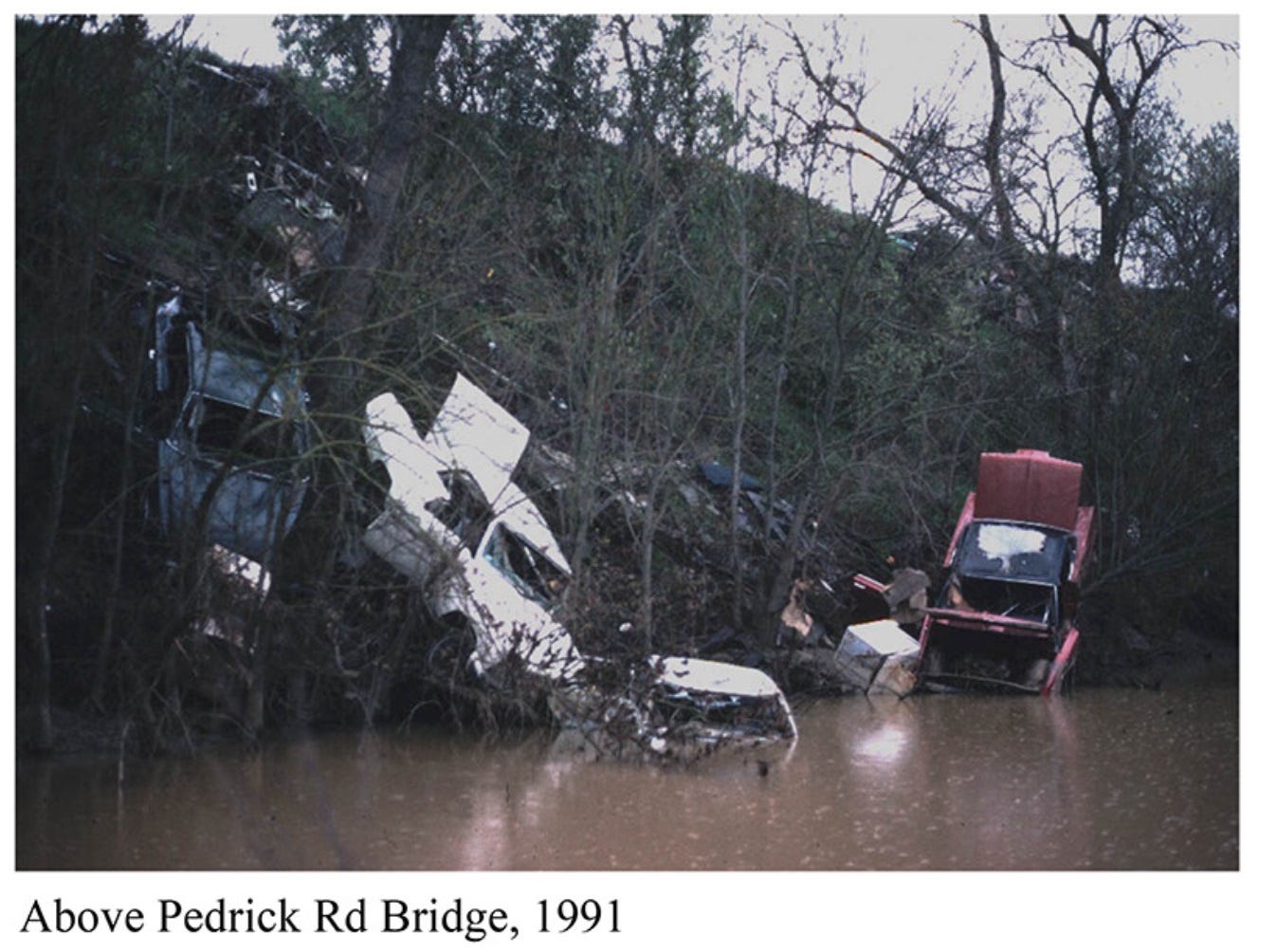This is how you save a river: A lawsuit, a streamkeeper and 80 tons of gravel
A college community decided a dried creek filled with wrecked cars should instead be home to salmon, trout, beavers, eagles and bears.
When I first heard my old friend Max Stevenson had become a “streamkeeper,” I imagined him donning a dark robe, holding a staff and demanding passwords for crossing what must be a magical strip of water.
When I finally got a chance to ask him about it, he said I’m not far off.
“It actually is kind of magical,” he said with a chuckle as he fired off a list of species that now inhabit the 23-mile (37 km) section of creek under his watch in Northern California, including salmon, rainbow and steelhead trout, osprey, eagles, mink, river otters, beavers and black bears.
Once extinct here, king salmon weighing up to 30 pounds (13.6 kg) have forged a home in the creek that was all but dry 24 years ago, thanks to a landmark lawsuit, plenty of water and $25 million in restoration.

This rebound comes as king (chinook) salmon stocks are declining elsewhere due to climate change and habitat loss. Some of that decline is reversible, say scientists who study Putah Creek.1 The creek’s recovery — after a landmark accord in 2000 restored water flows — should be used as a restoration model elsewhere.
From Andrew Rypel, et al, at California Water Blog:
The stream and its riparian areas are a nature refuge for local residents, a field site for teaching students, and increasingly a science lab for studying restoration. … [S]imilar strategies could be used to [recover] ecological capacity in other degraded streams.
Dammed, dried and diverted
Things weren’t always magical on Putah Creek. In the late 1880s, Putah Creek’s south fork was diverted to protect Davis, now a university town, from flooding. Levees were built around nearby Sacramento and smaller dams were installed in Putah Creek to provide water for agriculture. Finally, in 1957, Monticello Dam was completed to form Lake Berryessa, which changed all natural flows downriver.
After years of extended drought in the early 1990s, the creek began to completely dry out in summer. This left fish, birds and farmers straining for livelihood.
The Putah Creek Council, an offshoot of Audubon, brought a lawsuit spanning ten years to bring flows back to the river. Negotiations involved water agencies, two counties, a city, a university, landowners and farmers.
Finally, in 2000, after a judge’s favorable rulings, the parties agreed to the Putah Creek Accord, which mandated:
Water: Managers must increase flows from the dam in a way that mimics nature (think spring runoff) and helps both year-round and anadromous2 fish thrive.
Money: A small property tax has funded $25 million in restoration like getting rid of stagnant ponds and widening channels, as well as monitoring and management, including a unique position to oversee it all called a …
Streamkeeper.
A streamkeeper to watch over it all

Since taking over from longtime Streamkeeper Rich Marovich three years ago, Stevenson has been working with the 25 Solano County Water Agency staff to improve culverts, fine-tune fish passage and habitat, place large logs3 to protect baby salmon, manage beavers, and dump 80 tons of gravel to help bolster spawning.
Only two percent of the salmon born in Putah Creek are making it to the ocean, and Stevenson suspects it’s barriers to fish passage and lack of cover from predators that are the culprits.
“The creek has been really hammered with gravel extraction, sewage ponds, recreational bulldozing and misguided flood control measures,” Stevenson said.
Did he say “recreational bulldozing”? Yes, that’s what some Americans do for fun.
Back to salmon.
Salmon need gravel to spawn. It’s the only place they’ll lay their eggs. “Gravel scarification,” or breaking up compacted sediment that’s settled in the creek bed, has also proven effective. Stevenson calls it “fluffing the gravel.” See video below.
Salmon bring back the entire ecosystem
“The concept is to focus on charismatic megafauna, if you take care of that one big species, like the salmon, everything else comes along with it,” Stevenson continued. “The shady riparian habitat you might need for the salmon is also wildlife habitat for birds and bugs, and wildlife corridor for all sorts of animals. We’ve got bears and bald eagles eating this salmon in Putah Creek!”
As a university town, Davis contains a high density of PhDs with time, interest and energy to study the creek. Monitoring has shown decreases in non-native fish and increases in native fish since the accord was adopted.4 At the last eDNA5 survey, 26 different species of fish were detected, four mammals and one turtle species. Numbers of birds have doubled in some areas. Gigantic king salmon have returned by the thousands some years.

IF YOU BRING THE GRAVEL:

BIG FISH WILL SPAWN:
In 2022, Stevenson arranged to dump 80 tons of gravel under a pedestrian bridge in Winters, California. Returns were immediate. Salmon used this section of new gravel to lay 17 redds (nest depressions) containing thousands of eggs each.
Though he holds a PhD in biology, which he calls his “PhD in pistachios,” Stevenson has worked in hydrology most of his career. How does that work, you ask? He’s pretty nonchalant about it: “The flow calculations of the vessels of a plant, the xylem and phloem, are identical to the engineering calculations for the flow in pipes or the flow calculations of a canal. It’s also the same as veins and arteries in people.”
OK, yes, this is the right person for the job.
Nowadays, the Streamkeeper has his eye on murky Toe Drain, an unfortunate 12-mile stretch of water that Putah Creek drains into before it hits the delta that leads to San Francisco Bay. The salmon miraculously do make it through this “ag ditch with no flow requirements and no management.” It’s also full of aquatic weeds and straight as an arrow.
The Toe Drain, agriculture ditch and king salmon mud gauntlet:
From the adult salmon's perspective, Toe Drain is the first section of “fresh” water they encounter once they swim up from San Francisco Bay. After that, they encounter a wooden dam owned by California Fish & Wildlife that’s used to flood 17,000 acres of critical bird habitat and a wildlife refuge. In a few weeks, Stevenson’s crew will insert a wooden fish ladder at the dam to help the salmon make it to Putah Creek proper.
Nowadays, the Streamkeeper has an idea that will allow both baby salmon to exit and adult salmon to arrive: Create a new “river” to bypass Toe Drain.
“How are we going to do that?” he says, “Well, let’s figure it out. In a canal, the water company is the master. In a creek, there’s no one master. People kind of do what they want. You have to bring people along and co-create the solutions.”
This is where he’s got to do some heavy lifting. He knows where to put the new river, but the idea would involve multiple state and county agencies, plus private landowners coming together. Permits, permissions, conversations, exchanges of information, databasing, mapping, measuring existing flows, environmental impact reports. All the fun stuff of conservation!
The key to success?
“You’ve got to have a community of people, even if they’re on different sides,” Stevenson said. “You’ve got to get them together to co-create a new vision for the future. You’ll find the money, you’ll find the water, but if everyone’s fighting, you won’t get any of that.
“You keep people at the table and eventually you’ll see each other’s humanity and see a path forward, everyone gets something. We can accomplish things together that you’d never be able to accomplish through 20 years of lawsuits and hiding in the sand. You can be 100 percent correct technically and it doesn’t mean anything if you can’t get people to go along with it.”
Climate reminder: Salmon carry carbon from oceans to forests
Remember that these incredible fish bring carbon from the ocean to the land, along with many other nutrients. Bears, eagles and other animals drag salmon bodies onto shore, where they decompose and fertilize the surrounding forest.
In Suzanne Simard’s powerful memoir, “Finding the Mother Tree,”6 she recounts studies that found distinct, ocean-based carbon isotopes deep in the wood of old-growth trees in Canada.
Salmon help forests grow faster, numerous studies have shown.
Anne Post with the Alaska Department of Fish & Game writes:
Streamside vegetation gets just under 25 percent of its nitrogen from salmon. Other researchers report up to 70 percent of the nitrogen found in riparian zone foliage comes from salmon. One study concludes that trees on the banks of salmon-stocked rivers grow more than three times faster than their counterparts along salmon-free rivers and, growing side by side with salmon, Sitka spruce take 86 years, rather the usual 300 years, to reach 50 cm thick.
Climate reminder #2: Wetlands are carbon sinks
Restoring streams, rivers, wetlands and riparian habitat in general helps sequester carbon. According to one Nature article, “Wetland soils contain some of the highest stores of soil carbon in the biosphere.”
So, overall, what does a streamkeeper keep?
When I ask Stevenson what was the most important, most pivotal piece of the success of Putah Creek, I imagine he’ll say something like, “the gravel, it was definitely the gravel,” or “the lawsuit” but instead he pauses and says, “community.”
Here’s when I realize what the Streamkeeper keeps. It’s not the water. It’s not the fish. It’s not the agriculture. It’s not the farmers or the government or the university. The streamkeeper keeps the community between them all.
Could your community use a streamkeeper?
California water ideas that deserve more attention (California Water Blog):
A streamkeeper for every stream. There are many lessons to be gleaned from the Putah Creek experience, but the important role and potential for streamkeepers is one of the big ones. Watershed planning, while highly effective, is a challenging proposition – but a streamkeeper can aid in making this a reality.
GRAVEL SCARIFICATION, ie “FLUFFING”
My favorite recent reads:
“The false dichotomy of systemic and individual behaviour change,” by
No, you’re not going to solve climate change by swapping your beefburger for a meat substitute one. But your impact is also a bit higher than the carbon savings of your burger alone. When we buy products like meat substitutes we’re sending a signal to the market — to existing companies and new innovators — that there is demand.
“Quaint” by
, a rich, hearty stew of a read you should only attempt when you have a slow moment to sit and sip and think.Unlike other species, though, humans are born without a clear sense of how to live, despite having an immense capacity to verbalize the nature of our existence.
“Silent Solar: Some really really good news you haven't heard,” by
Solar panels have, over the last months, suddenly gotten so cheap that they’re now appearing in massive numbers across much of the developing world. Without waiting for what are often moribund utilities to do the job, business and home owners are getting on with electrifying their lives, and doing it cleanly.
“death on the beach,” by
, a fun foray into horror non-fiction with an eco twist.A dismembered tail flung haphazardly against a rock, a bony carcass at the base of a tree, an uneaten fully decomposing body a few feet to my right. And another. And another.
Orion Magazine: “Protecting the Prairie”7
WOODY ENCROACHMENT into the American prairie is a product of modern realities, yes, but those realities were designed to the tastes of European colonizers who knew the ways of—and found comfort in—forests. Their perspective is evident in our cultural notion that planting a tree is, always and without question, a very good thing. Arbor Day originated in the prairie state of Nebraska, where white settlers planted a million trees in one day in 1872. The state, where less than 2 percent of tallgrass prairie remains, now boasts the largest forest planted by hand in the Western Hemisphere.
California Nears Historic Conservation Goal With Over 25% of State Protected
Bangkok turns to urban forests to beat worsening floods
Interior announces new wildlife refuge in Oregon
UK: How farms are using 'magic dust' to capture carbon (this reminds me of the recent stories on biochar for the same purpose)
The dust is crushed basalt – volcanic rock which can be found in abundance in quarries across the country. The magic comes from its ability to both capture carbon dioxide from the atmosphere and help crops grow through a process known as enhanced rock weathering.
An aquatic weevil helps save African manatees (Read the last part. I love this guy.)
About Earth Hope:
Earth Hope is a solutions-based journalism project that highlights environmental success stories from around the globe, because hope is the foundation of progress. Consuming bad news is important, but we should also remind ourselves frequently that progress happens every day. Read more.
About me:
I’m Amanda Royal, a former newspaper reporter who covered wildfires, invasive species, water quality, wildlife and other environmental topics in California and Nevada (while writing under my maiden name and byline Amanda Fehd). The pseudonym “Earth” was a bit accidental. It grew on me quickly, so I thought I’d keep it for a while. I’m new to Substack as of late July 2024. Thanks for the wonderful reception!
Signing off with a little snippet from Notes:
According to CityofWinters.org, the name of this river is derived from a Native American village: “Putah Creek got its name from the Patwin village of Puta or Puta-to which was once located upstream from Winters in the now inundated Berryessa Valley. The Patwin village of Liwai or Liwai-to was located on Putah Creek and was estimated to have had a population of about 400.”
Fish that swim to and from the ocean.
Contrary to popular aesthetics, there are Benefits of Large Woody Debris in Streams. I might have to place this link in every post I write.
If you are into fish assemblage, please nerd out on the graphs at the California Water Blog: Putah Creek’s rebirth: a model for reconciling other degraded streams? and Increasing stability of a native freshwater fish assemblage following flow rehabilitation
Much easier than foot surveys or lengthy field observations, eDNA is a water sampling technique that extracts fragments of waste or other biological materials left behind in water and produces DNA matches with known species.
I cannot recommend this book enough. The tears flowed for hours.
Thanks to
for his link to this article. I’m looking forward to writing about prairie restoration soon.










I really love the term stream keeper and I believe everyone is capable. Restoring land and bodies of water and other places to gather is a way to commune together, this is special, just like the salmon in the putah river getting another chance to thrive. So, are salmon considered keystone species? I too have been inspired by Finding the Mother Trees book, so many connections that go unseen by our human eyes!
A remarkable success restoring Putah Creek. And we need more of it. Some of what human activity has destroyed, intentionally or not, is, and can be, restored. I assume all of the "Good News algorithms" will pick up on this. Thank you, Amanda Royal. We could, perhaps, clone Max Stevenson and create a college of Max Stevenson Streamkeepers. Similar to Tom Cruise in Oblivion (2013). Hopefully, Max, it will work out better for you. It's freaking beautiful. Go Max! Who doesn't love "charismatic megafauna"? Clear the Toe Drain and Godspeed to you.